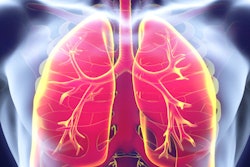
Using a risk prediction model to figure out which nodules to work up helped reduce the false-positive rate in a CT lung cancer screening trial by more than threefold, compared with rates using previous criteria, according to an article published online May 15 in the Journal of the American College of Radiology.
Various groups have presented a wide range of strategies to address concerns over the high false-positive rate associated with CT lung cancer screening. The proposed strategies, for example, range from prescreening eligible smokers for recent respiratory illnesses to using artificial intelligence to aid radiologists in nodule detection.
In the current study, researchers from Canada assessed the potential of a new lung nodule evaluation method to reduce false-positive rates. The method hinges on categorizing lung nodules using a proprietary nodule risk classification (NRC) approach, which is based on the Pan-Canadian Early Detection of Lung Cancer (PanCan) risk prediction model.
Previous large-scale screening trials such as the National Lung Screening Trial (NLST) and the Dutch-Belgian Randomized Lung Cancer Screening (NELSON) trial have relied on nodule measurements to determine cancer risk, but classifying a nodule as malignant based on size alone may have contributed to higher false-positive rates, wrote lead author Dr. Alain Tremblay and colleagues from the University of Calgary.
The researchers applied their NRC approach to 775 individuals who underwent CT lung screening as part of the Alberta Lung Cancer Screening study. All participants had to either meet the NLST screening criteria or have an estimated six-year lung cancer risk of at least 1.5% based on the PanCan risk model.
Overall, Tremblay and colleagues found that categorizing nodule risk using their NRC approach resulted in less than a third of the number of false-positive exams that were reported when using the NLST criteria for classifying nodule risk, without lowering diagnostic accuracy. The NRC approach also matched the American College of Radiology (ACR) lung screening reporting and data system (Lung-RADS) for nodule management, with no statistically significant difference between the two methods in terms of accuracy.
| Comparison of nodule management approaches for CT lung cancer screening | |||
| NLST criteria | Lung-RADS | NRC | |
| Area under the curve for a positive screen | 0.845 | 0.844 | 0.918 |
| False-positive rate* | 32.8% | 9.3% | 9.2% |
In addition, the group discovered that most of the false-positive cases reported using the NRC method contained ground-glass nodules. These nodules tend to be indolent and nonaggressive, and so adjusting the NRC method to increase the risk threshold for ground-glass nodules could help further decrease the false-positive rate to 6.7%, without missing any invasive cancers, the authors noted.
"The NRC approach has the potential to offer a more specific test without a decline in sensitivity, critical to maintain the early detection rates associated with the mortality benefit of screening," they concluded.




















